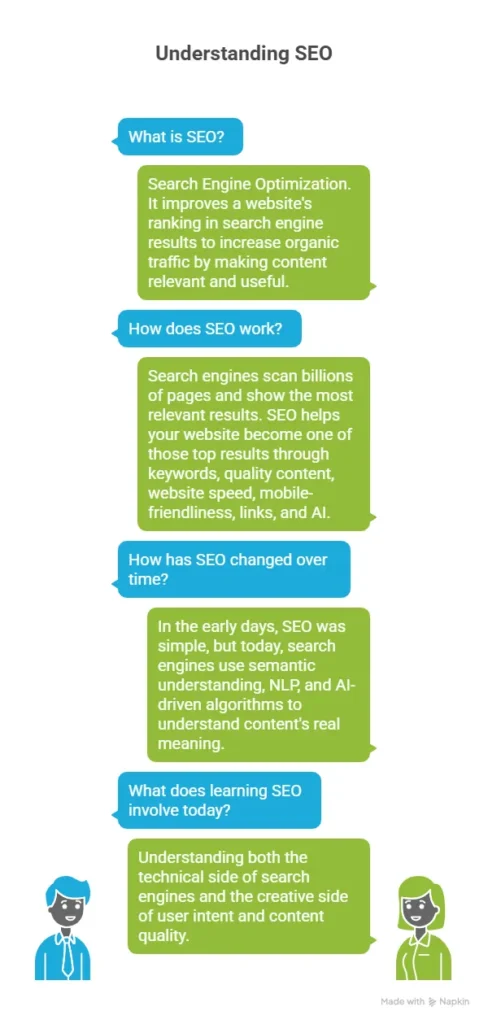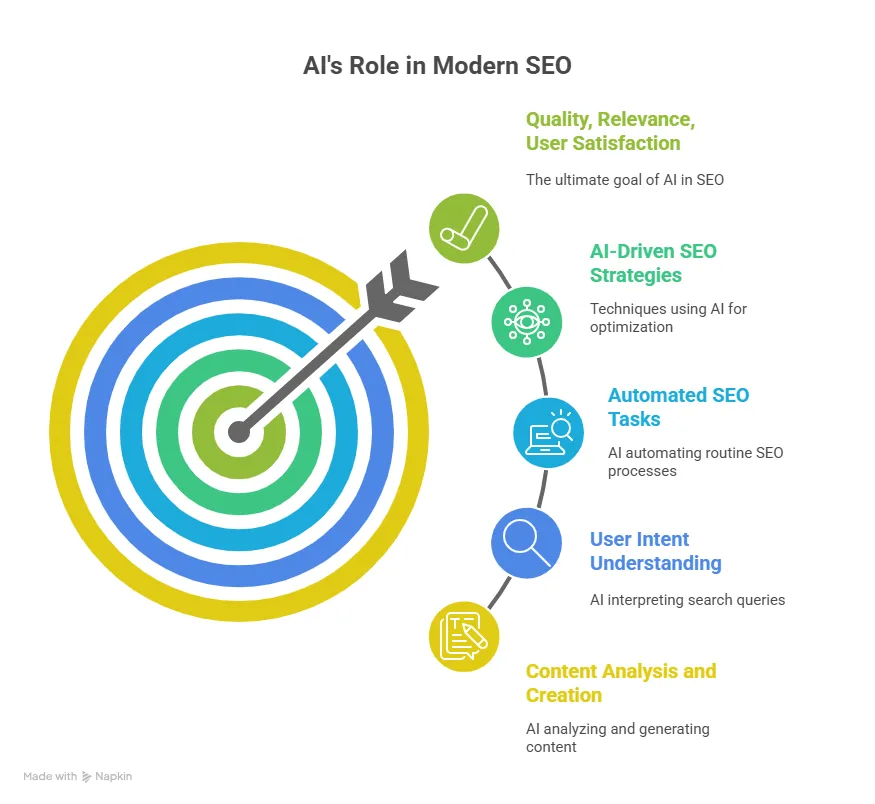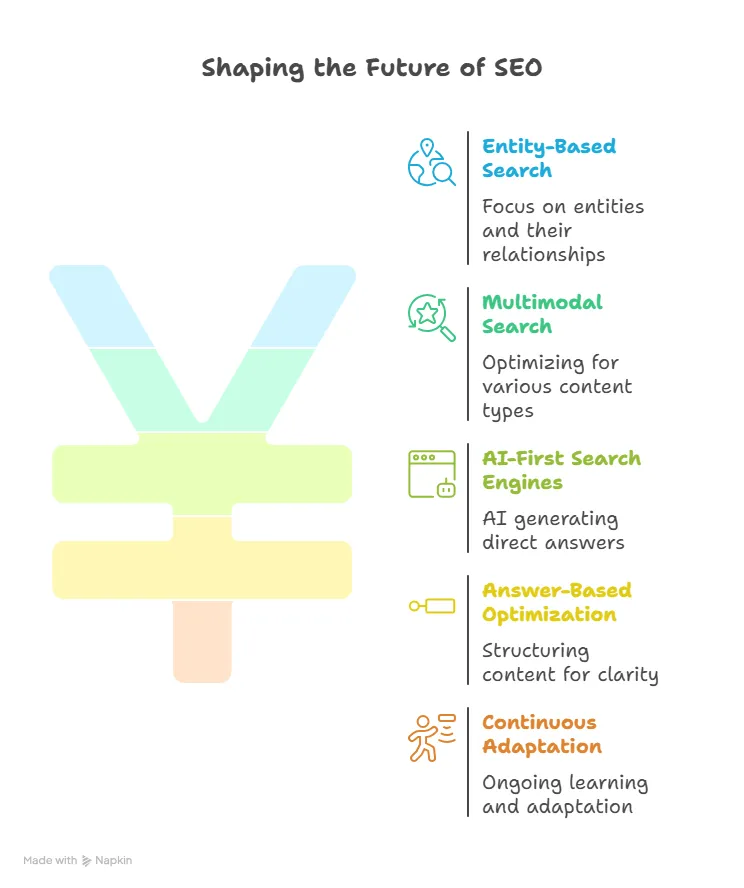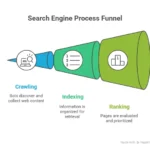SEO is one of the most important parts of digital marketing. It helps websites appear on top of Google search results when people search for something online. Every business, from small shops to global brands, uses SEO to reach more people, build trust, and grow sales. But SEO is not just about keywords anymore – it has evolved with artificial intelligence, algorithms, and human-like understanding of language.
Introduction
SEO stands for Search Engine Optimization. It is the process of improving a website so that it appears higher in search engine results like Google, Bing, or Yahoo. The goal of SEO is to increase organic (non-paid) traffic by making your content more relevant and useful to users and search engines.
When someone searches for information online, search engines scan billions of pages and show the most relevant results. SEO helps your website become one of those top results. It involves many elements — keywords, quality content, website speed, mobile-friendliness, links, and now even AI and machine learning.
In the early days, SEO was simple. Adding keywords and links was enough to get ranked. But today, search engines are much smarter. They use semantic understanding, natural language processing (NLP), and AI-driven algorithms to understand the real meaning of content.
So, learning SEO today means understanding both the technical side of search engines and the creative side of user intent and content quality. This article will help you explore what SEO is, its history, how it evolved, and where it is heading in the era of AI and generative search.

Purpose and Use of SEO
The main purpose of SEO is to help websites get more visibility in search engines. When people search for information, products, or services, they usually click on one of the top results. SEO helps your website appear in those top positions so that more users visit your site.
SEO is not just about ranking higher, it is about reaching the right audience at the right time. It connects your business with people who are already searching for what you offer. For example, if someone searches for “best digital marketing course in Kerala”, SEO ensures that your course page appears when the search is made.
Good SEO helps build trust and credibility. People trust search engines, and when your website appears in top results, they believe your brand is reliable. SEO also improves user experience by making your website faster, easier to use, and mobile friendly.
Another key use of SEO is that it gives long-term results. Unlike paid ads, which stop giving traffic when the budget ends, SEO continues to bring visitors month after month if done correctly. It also helps in reducing marketing costs over time, since organic traffic is free once you rank well.
In short, SEO increases visibility, attracts quality visitors, builds brand trust, and helps you achieve long-term online success.
History of SEO
The history of SEO began in the early days of the internet, during the mid-1990s, when the first search engines like Yahoo, AltaVista, and Lycos were created. Back then, websites were few, and ranking was simple. Search engines mainly relied on meta tags and keyword density to understand what a page was about. If someone wanted to rank higher, they just needed to repeat their target keywords several times in the content or meta tags.
As the internet grew, people started finding ways to manipulate rankings. Techniques like keyword stuffing, hidden text, and link farms became common. Search engines began to face a major problem, as low-quality sites often ranked higher than genuine ones.
When Google entered the scene in 1998, everything started to change. Google introduced a new system called PageRank, which measured a site’s importance based on how many other sites linked to it. This made SEO more complex and shifted the focus from just keywords to links and authority.
During the 2000s, SEO started becoming a professional field. Experts began studying how search algorithms worked, how backlinks affected ranking, and how content quality influenced results. Google kept refining its algorithm to provide better user experiences and to fight spammy SEO practices.
Over the next two decades, SEO evolved from a keyword-based strategy to a complex system involving content relevance, user intent, page speed, mobile optimization, and AI-based ranking signals. From a simple method to get noticed online, SEO became a science that blends technology, psychology, and creativity.
Evolution of SEO Through Google Algorithm Updates
Google’s success came from its ability to deliver better and more relevant search results than any other search engine. To maintain this quality, Google has introduced hundreds of algorithm updates over the years. Each update aimed to reduce manipulation and improve user experience. Below are the major updates that changed the path of SEO.
1. Florida Update (2003)
This was Google’s first major update. It targeted websites using spammy tactics like keyword stuffing and hidden links. Many businesses that relied on these shortcuts lost their rankings overnight. The update marked the beginning of quality-focused SEO.
2. Panda Update (2011)
The Panda update was designed to improve content quality. It penalized websites with duplicate, thin, or low-value content. This encouraged publishers to focus on unique, helpful, and well-written articles that provide real value to readers.
3. Penguin Update (2012)
This update focused on the quality of backlinks. Websites that used paid links or participated in link exchange networks were penalized. Google wanted links to represent genuine trust, not a trick to boost rankings.
4. Hummingbird Update (2013)
Hummingbird brought a major shift from keywords to intent. It helped Google understand the meaning behind search queries rather than just matching exact words. This update marked the start of semantic SEO, where context and topics became more important than single keywords.
5. RankBrain Update (2015)
RankBrain introduced machine learning into SEO. It helped Google analyze and interpret unfamiliar or complex search queries using AI. This was the foundation of modern intelligent search, where the system learns and improves continuously.
6. BERT Update (2019)
BERT (Bidirectional Encoder Representations from Transformers) made Google better at understanding natural language. It focused on how words relate to each other in a sentence. This update allowed Google to understand conversational queries more like a human does.
7. Helpful Content and Core Updates (2022–Present)
These updates focus on user-first content. Google now ranks pages that genuinely help users and demotes those created only for search rankings. It also considers E-E-A-T factors: Experience, Expertise, Authoritativeness, and Trustworthiness.
Each of these updates pushed SEO professionals to become smarter and more ethical. The evolution from keyword tricks to AI-driven analysis shows how search engines have grown closer to understanding human language and behavior.
Semantic SEO
Semantic SEO is about optimizing content based on meaning, not just words. The word “semantic” refers to understanding the relationship between words, topics, and intent. Instead of matching exact keywords, Google now tries to understand what users actually mean when they search.
Earlier, SEO focused mainly on adding the right keywords to titles, headings, and meta tags. But after Google’s Hummingbird and RankBrain updates, the focus shifted to context. Search engines started analyzing how words connect to each other and what topic they describe.
For example, if a person searches for “how to fix a slow website,” Google understands that the user might be looking for solutions related to hosting, image compression, caching, or coding issues. So, content that explains these areas together will rank better than one that only repeats the phrase “fix a slow website.”
Semantic SEO uses entities and relationships between them. An entity can be a person, place, thing, or concept that has a specific meaning in the real world. Google’s Knowledge Graph is built on entities, helping it understand that “Apple” can mean a fruit or a company, depending on context.
To apply semantic SEO, you should:
- Write content that answers user intent, not just keywords.
- Use related terms, synonyms, and topic clusters.
- Add structured data (schema markup) to help search engines identify key entities.
- Create detailed, connected content that covers a topic fully.
Semantic SEO helps search engines deliver more accurate results and helps websites build topical authority. When you cover a topic deeply and link related content together, Google identifies your site as a reliable source for that subject.
NLP (Natural Language Processing) in SEO
Natural Language Processing (NLP) is a field of artificial intelligence that helps computers understand human language. In SEO, NLP allows search engines like Google to read, interpret, and understand the meaning of text more like a human reader.
Earlier, search engines mostly looked for keywords and link signals. But with NLP, Google can now identify the intent, tone, and context of a search query or a piece of content. This helps it match results more accurately to what the user really wants.
The real breakthrough came with Google’s BERT update in 2019. BERT helped Google understand how words relate to each other within a sentence. For example, in the query “how to book a flight to Paris,” BERT understands that “to Paris” is the destination, not part of a random phrase.
Later, Google introduced MUM (Multitask Unified Model), a more advanced AI model that understands information across languages and formats such as text, images, and videos. MUM can analyze content like an expert, finding relationships that go beyond simple text matching.
In practical SEO, NLP is now used to:
- Identify entities and their relationships in content.
- Understand the emotional tone and readability of text.
- Improve keyword research using intent-based clusters.
- Optimize content for voice and conversational searches.
NLP also powers tools like Google Natural Language API, Glimpse, and MarketMuse, which analyze content quality and topical depth. By applying NLP concepts, SEO professionals can create content that aligns with how search engines interpret meaning, not just how they count words.
In short, NLP has transformed SEO from a keyword-driven practice into a meaning-driven discipline. It helps bridge the gap between what users say and what they actually mean, making content more natural, useful, and rank-worthy.
Local SEO
Local SEO is the practice of optimizing a website to appear in search results for a specific location. It is especially important for businesses that serve customers in a particular city, region, or neighborhood, such as restaurants, clinics, salons, or local stores.
Local SEO helps your business appear in the local pack, Google Maps, and location-based searches. For example, if someone searches for “best houseboats in Alleppey,” local SEO ensures that businesses in Alleppey show up at the top.
Key elements of Local SEO include:
- Google Business Profile (GBP): Claiming and optimizing your profile with accurate business details, images, and services.
- Local Citations: Consistent business information (name, address, phone) across directories and websites.
- Customer Reviews: Positive reviews improve trust and influence local ranking.
- Local Keywords: Including city or area names in content, titles, and meta descriptions.
- Mobile Optimization: Many local searches happen on mobile devices, so speed and usability are critical.
Local SEO also intersects with voice search, as people often use mobile assistants to find nearby services with phrases like “near me.”
By focusing on local SEO, businesses can attract high-intent visitors, increase foot traffic, and gain a competitive advantage in their specific area.
Ecommerce SEO
Ecommerce SEO is the process of optimizing online stores to rank higher in search engine results. Unlike regular websites, ecommerce sites have product pages, categories, filters, and often thousands of listings. SEO for ecommerce ensures that these pages are visible to potential customers searching for products online.
Key elements of ecommerce SEO include:
- Product Optimization: Titles, descriptions, images, and metadata must be clear, unique, and keyword-rich.
- Site Structure: Categories and subcategories should be well-organized to make it easy for both users and search engines to navigate.
- Schema Markup: Structured data for products, prices, availability, and reviews helps search engines display rich results.
- Handling Duplicate Content: Product variations and filters can create duplicate pages, which need to be managed with canonical tags or noindex rules.
- Internal Linking: Linking related products and categories improves crawlability and user navigation.
- Page Speed & Mobile Optimization: Fast-loading, mobile-friendly pages enhance user experience and improve rankings.
Ecommerce SEO also includes optimizing for marketplaces like Amazon or Shopify, where competition is high and rankings directly impact sales. Proper SEO ensures that your products reach the right audience, increase conversions, and grow revenue.
With the rise of AI tools, ecommerce SEO can now also include AI-generated product descriptions, keyword research, and automated content optimization, making it easier to manage large catalogs.
The Role of AI in Modern SEO
Artificial Intelligence (AI) has transformed SEO in recent years. Search engines now use AI to understand content, user behavior, and intent more accurately. This has changed how SEO professionals approach optimization and content creation.
AI in SEO helps in several ways:
- Content Analysis and Creation: AI tools can analyze top-ranking pages, suggest topics, generate outlines, and even create drafts of content.
- User Intent Understanding: AI models like Google’s MUM and BERT interpret the meaning behind search queries to deliver more relevant results.
- Automated SEO Tasks: AI can audit websites, check for technical errors, suggest keyword optimizations, and monitor ranking changes.
- Predictive SEO: AI predicts trends, identifies gaps in content, and helps strategize for future search patterns.
Two emerging concepts in AI-driven SEO are:
- GEO (Generative Engine Optimization): Optimizing content for AI-generated search results, where answers may be created dynamically rather than just ranking pages.
- ASEO (AI Search Engine Optimization): Techniques focused on optimizing for AI-powered search engines that generate summaries, answers, or multi-format results.

AI has made SEO more intelligent, focusing on quality, relevance, and user satisfaction rather than just keywords or backlinks. SEO professionals now need to combine technical knowledge with AI-driven strategies to stay competitive.
Future of SEO
The future of SEO is closely tied to artificial intelligence, user experience, and evolving search behavior. As search engines become smarter, SEO will continue to move from keyword-based optimization to intent-driven and AI-driven strategies.
Key trends shaping the future of SEO include:
- Entity-Based Search: Search engines will focus more on entities like people, places, and concepts rather than just keywords. Understanding relationships between entities will be crucial.
- Multimodal Search: Users will search using text, voice, images, and videos. SEO strategies will need to optimize for all types of content.
- AI-First Search Engines: Generative AI and large language models will create answers directly for users, which means websites may need to optimize for being cited or referenced rather than just ranked.
- Answer-Based Optimization: Featured snippets, knowledge panels, and AI-generated summaries will dominate search results. Content will need to be structured for clarity and direct answers.
- Continuous Adaptation: Search engine algorithms and AI models will keep evolving. SEO professionals must keep learning and adapting to maintain visibility and authority.

In this evolving landscape, understanding semantic relevance, user intent, AI-driven content, and structured data will be essential for any successful SEO strategy. While the methods may change, the core goal remains the same: helping users find the most relevant, trustworthy, and valuable content.
A complete SEO strategy includes multiple components working together. On-page SEO focuses on optimizing individual pages through elements like titles, headings, content, and internal links. Off-page SEO builds your website’s authority through activities like backlinks, social signals, and brand mentions. Combining both approaches ensures higher visibility, better rankings, and more targeted traffic to your site.
Conclusion
SEO has come a long way from simple keyword stuffing and link-building techniques. Today, it is a complex field that combines technical expertise, content strategy, and user experience. From its early days in the 1990s to the AI-driven world of GEO and ASEO, SEO has continuously evolved to meet the demands of smarter search engines and more discerning users.
Understanding SEO means understanding how search engines work, what users are looking for, and how content can best meet those needs. Concepts like semantic SEO, NLP, local SEO, ecommerce SEO, and AI-driven optimization are now essential tools for professionals and businesses alike.
For beginners, the key takeaway is that SEO is not just about ranking higher. It is about providing value, building credibility, and adapting to changes in technology and search behavior. By learning and applying these principles, businesses and content creators can ensure long-term visibility, growth, and relevance in the digital world.
SEO will continue to evolve, but the focus on user satisfaction and high-quality content will always remain at its core. Staying updated, embracing AI, and creating meaningful content are the steps to succeed in the future of search.
